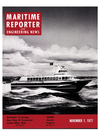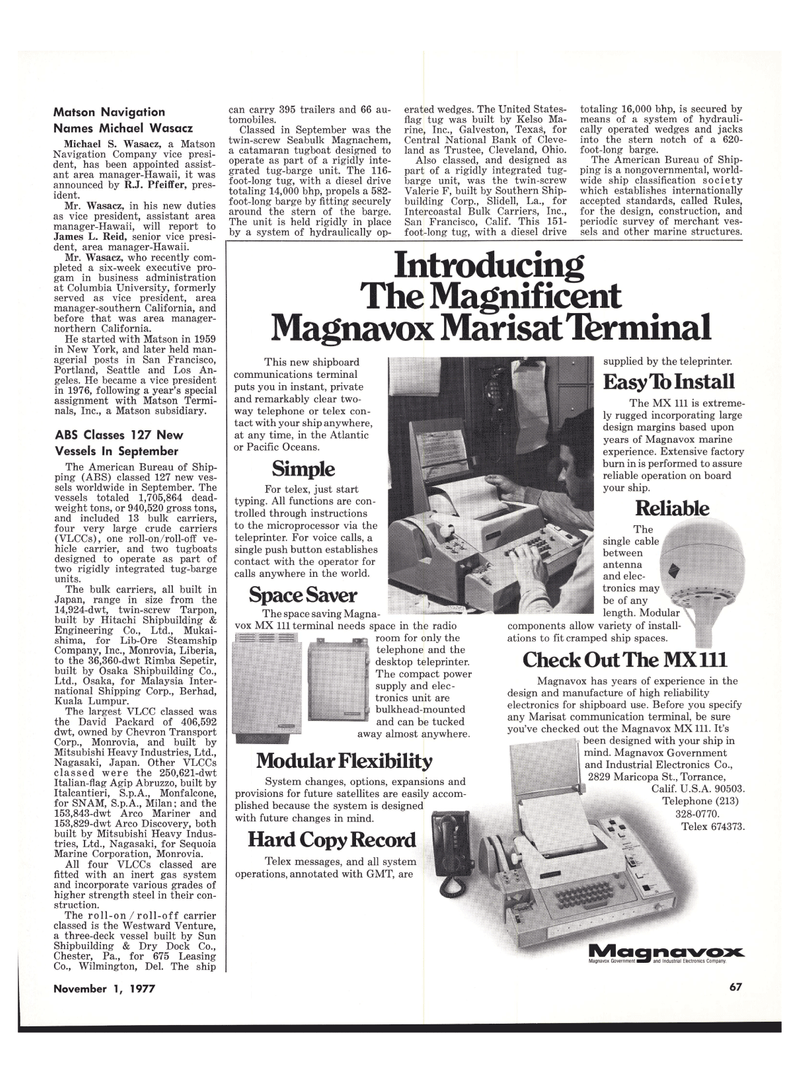
Page 65: of Maritime Reporter Magazine (November 1977)
Read this page in Pdf, Flash or Html5 edition of November 1977 Maritime Reporter Magazine
Matson Navigation
Names Michael Wasacz
Michael S. Wasacz, a Matson
Navigation Company vice presi- dent, has been appointed assist- ant area manager-Hawaii, it was announced by R.J. Pfeiffer, pres- ident.
Mr. Wasacz, in his new duties as vice president, assistant area manager-Hawaii, will report to
James L. Reid, senior vice presi- dent, area manager-Hawaii.
Mr. Wasacz, who recently com- pleted a six-week executive pro- gam in business administration at Columbia University, formerly served as vice president, area manager-southern California, and before that was area manager- northern California.
He started with Matson in 1959 in New York, and later held man- agerial posts in San Francisco,
Portland, Seattle and Los An- geles. He became a vice president in 1976, following a year's special assignment with Matson Termi- nals, Inc., a Matson subsidiary.
ABS Classes 127 New
Vessels In September
The American Bureau of Ship- ping (ABS) classed 127 new ves- sels worldwide in September. The vessels totaled 1,705,864 dead- weight tons, or 940,520 gross tons, and included 13 bulk carriers, four very large crude carriers (VLCCs), one roll-on/roll-off ve- hicle carrier, and two tugboats designed to operate as part of two rigidly integrated tug-barge units.
The bulk carriers, all built in
Japan, range in size from the 14,924-dwt, twin-screw Tarpon, built by Hitachi Shipbuilding &
Engineering Co., Ltd., Mukai- shima, for Lib-Ore Steamship
Company, Inc., Monrovia, Liberia, to the 36,360-dwt Rimba Sepetir, built by Osaka Shipbuilding Co.,
Ltd., Osaka, for Malaysia Inter- national Shipping Corp., Berhad,
Kuala Lumpur.
The largest VLCC classed was the David Packard of 406,592 dwt, owned by Chevron Transport
Corp., Monrovia, and built by
Mitsubishi Heavy Industries, Ltd.,
Nagasaki, Japan. Other VLCCs classed were the 250,621-dwt
Italian-flag Agip Abruzzo, built by
Italcantieri, S.p.A., Monfalcone, for SNAM, S.p.A., Milan; and the 153,843-dwt Arco Mariner and 153,829-dwt Arco Discovery, both built by Mitsubishi Heavy Indus- tries, Ltd., Nagasaki, for Sequoia
Marine Corporation, Monrovia.
All four VLCCs classed are fitted with an inert gas system and incorporate various grades of higher strength steel in their con- struction.
The roll-on / roll-off carrier classed is the Westward Venture, a three-deck vessel built by Sun
Shipbuilding & Dry Dock Co.,
Chester, Pa., for 675 Leasing
Co., Wilmington, Del. The ship can carry 395 trailers and 66 au- tomobiles.
Classed in September was the twin-screw Seabulk Magnachem, a catamaran tugboat designed to operate as part of a rigidly inte- grated tug-barge unit. The 116- foot-long tug, with a diesel drive totaling 14,000 bhp, propels a 582- foot-long barge by fitting securely around the stern of the barge.
The unit is held rigidly in place by a system of hydraulically op- erated wedges. The United States- flag tug was built by Kelso Ma- rine, Inc., Galveston, Texas, for
Central National Bank of Cleve- land as Trustee, Cleveland, Ohio.
Also classed, and designed as part of a rigidly integrated tug- barge unit, was the twin-screw
Valerie F, built by Southern Ship- building Corp., Slidell, La., for
Intercoastal Bulk Carriers, Inc.,
San Francisco, Calif. This 151- foot-long tug, with a diesel drive totaling 16,000 bhp, is secured by means of a system of hydrauli- cally operated wedges and jacks into the stern notch of a 620- foot-long barge.
The American Bureau of Ship- ping is a nongovernmental, world- wide ship classification society which establishes internationally accepted standards, called Rules, for the design, construction, and periodic survey of merchant ves- sels and other marine structures.
Introducing The Magnificent
Magnavox Marisat Terminal
Magnavox Government^SP and Industrial Electronics Company.
This new shipboard communications terminal puts you in instant, private and remarkably clear two- way telephone or telex con- tact with your ship anywhere, at any time, in the Atlantic or Pacific Oceans.
Simple
For telex, just start typing. All functions are con- trolled through instructions to the microprocessor via the teleprinter. For voice calls, a single push button establishes contact with the operator for calls anywhere in the world.
SpaceSaver
The space saving Magna- vox MX 111 terminal needs space in the radio room for only the k"' ' ' " ~'t telephone and the 1 | desktop teleprinter. | I The compact power |. [ supply and elec-
I tronics unit are
I raj '$ bulkhead-mounted and can be tucked away almost anywhere.
Hard Copy Record
Telex messages, and all system operations, annotated with GMT, are supplied by the teleprinter.
Easy To Install
Modular Flexibility
System changes, options, expansions and provisions for future satellites are easily accom- plished because the system is designed with future changes in mind.
The MX 111 is extreme- ly rugged incorporating large design margins based upon years of Magnavox marine experience. Extensive factory burn in is performed to assure reliable operation on board your ship.
Reliable
Check Out The MX 111
Magnavox has years of experience in the design and manufacture of high reliability electronics for shipboard use. Before you specify any Marisat communication terminal, be sure you've checked out the Magnavox MX 111. It's i been designed with your ship in ! mind. Magnavox Government 1 and Industrial Electronics Co., | 2829 Maricopa St., Torrance,
Calif. U.S.A. 90503.
Telephone (213) 328-0770.
Telex 674373.
The single cable between antenna and elec- tronics may be of any length. Modular components allow variety of install- ations to fit cramped ship spaces.
November 1, 1977 67

 64
64

 66
66
